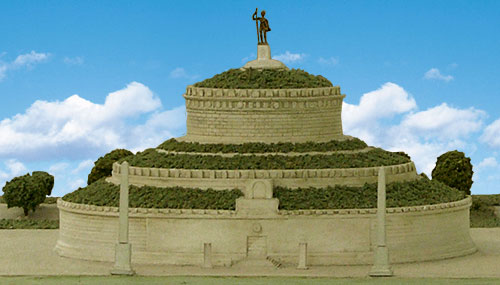
Suetonius dates the building of this structure as taking place between 28-23 BC. It is considered perhaps the first Augustan building in the Campus Martius area. Augustus had planned the area surrounding the mausoleum to be a public area filled with trees and walks. The mausoleum itself was probably a tumulus which sat on a base of white stone. Usually cypress trees growing from the tumulus and surrounding the upper monument are pictured. It is more likely that junipers would have been planted here since their root structure would have been less destructive to the stonework.
Strabo describes the structure as a great mound on a high foundation of white stone over tufa stone which was covered with trees. It appeared as a mound of earth which filled the empty spaces between three outer walls and continued upward over the vaulting of the inner three walls. He gives the diameter as 88 meters with a height about half the diameter...about 39 meters. The present height (1998) is about 98 ft. Strabo also describes a bronze statue at the top, rising out of the trees.
One entered from the south through a vaulted tunnel to a vaulted chamber. the entrance was flanked with obelisks now found in Piazza del Quirinale and the Piazza di S.Maria Maggiore. In AD 14, the bronze tablets of the Res Gestae, records of Augustus' achievements, were inscribed on bronze tablets at the entrance.
The absence of decor may be due to looting but it is generally considered a deliberate aesthetic design. The tumulus as a tomb form has a long history. The size, more than elaborate design, indicates the stature of those whose ashes rested within. In the 16th century, the Soderini family converted the upper portion of the tumulus.
The ashes of Marcus Claudius Marcellus, nephew of Augustus were the first inhumed in this mausoleum, in 23 BC; see the Inscription of Marcellus and Octavia found near the mausoleum (photo credit: J. Higginbotham). See also Who's Who in the Mausoleum, a list of those whose ashes probably rested here, and Mark Morford's Augustus: Images of Power, which provides more images and details about the mausoleum.